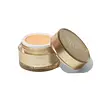What's inside
What's inside
 Key Ingredients
Key Ingredients

 Benefits
Benefits

 Concerns
Concerns

 Ingredients Side-by-side
Ingredients Side-by-side

Water
Skin ConditioningButylene Glycol
HumectantCyclopentasiloxane
EmollientGlycerin
HumectantCaprylic/Capric Triglyceride
MaskingDicaprylyl Carbonate
EmollientGlycereth-26
HumectantPolysorbate 20
EmulsifyingHydroxyacetophenone
AntioxidantAcrylates/C10-30 Alkyl Acrylate Crosspolymer
Emulsion StabilisingAmmonium Acryloyldimethyltaurate/Vp Copolymer
Phenoxyethanol
PreservativeAminomethyl Propanol
BufferingParfum
MaskingSalicylic Acid
MaskingIron Oxides
Mica
Cosmetic ColorantDisodium EDTA
Water, Butylene Glycol, Cyclopentasiloxane, Glycerin, Caprylic/Capric Triglyceride, Dicaprylyl Carbonate, Glycereth-26, Polysorbate 20, Hydroxyacetophenone, Acrylates/C10-30 Alkyl Acrylate Crosspolymer, Ammonium Acryloyldimethyltaurate/Vp Copolymer, Phenoxyethanol, Aminomethyl Propanol, Parfum, Salicylic Acid, Iron Oxides, Mica, Disodium EDTA
Water
Skin ConditioningTrehalose
HumectantCaprylic/Capric Triglyceride
MaskingCetyl Ethylhexanoate
EmollientCyclopentasiloxane
EmollientCetearyl Alcohol
EmollientCoco-Glucoside
CleansingCetyl Alcohol
EmollientDimethicone
EmollientGlycerin
HumectantHydrogenated Olive Oil
Skin ConditioningLaminaria Digitata Extract
Skin ProtectingCassia Alata Leaf Extract
AstringentTremella Fuciformis Polysaccharide
Emulsion StabilisingSea Whip Extract
Skin ConditioningBifida Ferment Lysate
Skin ConditioningThermus Thermophillus Ferment
Skin ConditioningPhaeodactylum Tricornutum Extract
HumectantErgothioneine
AntioxidantArabidopsis Thaliana Extract
AntioxidantGeranylgeraniol
AntimicrobialPhytosteryl Isostearate
Skin ConditioningTocopherol
AntioxidantAcrylates/C10-30 Alkyl Acrylate Crosspolymer
Emulsion StabilisingButylene Glycol
HumectantPolysorbate 20
EmulsifyingSodium Dehydroacetate
PreservativeZea Mays Oil
EmulsifyingPhenyl Trimethicone
Skin ConditioningPhenoxyethanol
PreservativeEthylhexylglycerin
Skin ConditioningLecithin
EmollientHelianthus Annuus Seed Oil
EmollientWater, Trehalose, Caprylic/Capric Triglyceride, Cetyl Ethylhexanoate, Cyclopentasiloxane, Cetearyl Alcohol, Coco-Glucoside, Cetyl Alcohol, Dimethicone, Glycerin, Hydrogenated Olive Oil, Laminaria Digitata Extract, Cassia Alata Leaf Extract, Tremella Fuciformis Polysaccharide, Sea Whip Extract, Bifida Ferment Lysate, Thermus Thermophillus Ferment, Phaeodactylum Tricornutum Extract, Ergothioneine, Arabidopsis Thaliana Extract, Geranylgeraniol, Phytosteryl Isostearate, Tocopherol, Acrylates/C10-30 Alkyl Acrylate Crosspolymer, Butylene Glycol, Polysorbate 20, Sodium Dehydroacetate, Zea Mays Oil, Phenyl Trimethicone, Phenoxyethanol, Ethylhexylglycerin, Lecithin, Helianthus Annuus Seed Oil
Ingredients Explained
These ingredients are found in both products.
Ingredients higher up in an ingredient list are typically present in a larger amount.
Acrylates/C10-30 Alkyl Acrylate Crosspolymer is a synthetic polymer. It is used to thicken and improve the texture of products. Due to its properties, it can prevent water and oil ingredients from separating.
Butylene Glycol (or BG) is used within cosmetic products for a few different reasons:
Overall, Butylene Glycol is a safe and well-rounded ingredient that works well with other ingredients.
Though this ingredient works well with most skin types, some people with sensitive skin may experience a reaction such as allergic rashes, closed comedones, or itchiness.
Learn more about Butylene GlycolThis ingredient is an emollient, solvent, and texture enhancer. It is considered a skin-softener by helping the skin prevent moisture loss.
It helps thicken a product's formula and makes it easier to spread by dissolving clumping compounds.
Caprylic Triglyceride is made by combining glycerin with coconut oil, forming a clear liquid.
While there is an assumption Caprylic Triglyceride can clog pores due to it being derived from coconut oil, there is no research supporting this.
Learn more about Caprylic/Capric TriglycerideCyclopentasiloxane, or D5, is a silicone used to improve texture of products and trap moisture.
D5 is considered lightweight and volatile. Volatile means it evaporates quickly after application. Once evaporated, D5 leaves a thin barrier that helps keep skin hydrated.
It is also an emollient. Emollients help soften the skin and prevent water loss. Silicones create a silky texture in products. D5 helps other ingredients become more spreadable.
Studies show D5 is safe to use in skincare products. We recommend speaking with a skincare professional if you have concerns.
Learn more about CyclopentasiloxaneGlycerin is already naturally found in your skin. It helps moisturize and protect your skin.
A study from 2016 found glycerin to be more effective as a humectant than AHAs and hyaluronic acid.
As a humectant, it helps the skin stay hydrated by pulling moisture to your skin. The low molecular weight of glycerin allows it to pull moisture into the deeper layers of your skin.
Hydrated skin improves your skin barrier; Your skin barrier helps protect against irritants and bacteria.
Glycerin has also been found to have antimicrobial and antiviral properties. Due to these properties, glycerin is often used in wound and burn treatments.
In cosmetics, glycerin is usually derived from plants such as soybean or palm. However, it can also be sourced from animals, such as tallow or animal fat.
This ingredient is organic, colorless, odorless, and non-toxic.
Glycerin is the name for this ingredient in American English. British English uses Glycerol/Glycerine.
Learn more about GlycerinPhenoxyethanol is a preservative that has germicide, antimicrobial, and aromatic properties. Studies show that phenoxyethanol can prevent microbial growth. By itself, it has a scent that is similar to that of a rose.
It's often used in formulations along with Caprylyl Glycol to preserve the shelf life of products.
Polysorbate 20 is made by combining ethoxylation of sorbitan, ethylene oxide, and lauric acid. It is a mild cleansing agent, surfactant, and emulsifier.
As a surfactant, it helps collect dirt and oils for washing. Emulsifiers prevent oils and water from separating.
Polysorbate 20 also adds scent to a product. Since it is made using sorbitol, it has a sweet scent. Sorbitol can also be found in fruits such as apples and peaches.
The lauric acid used to create Polysorbate 20 is often derived from coconuts.
Polysorbate 20 may not be fungal acne safe.
Learn more about Polysorbate 20Water. It's the most common cosmetic ingredient of all. You'll usually see it at the top of ingredient lists, meaning that it makes up the largest part of the product.
So why is it so popular? Water most often acts as a solvent - this means that it helps dissolve other ingredients into the formulation.
You'll also recognize water as that liquid we all need to stay alive. If you see this, drink a glass of water. Stay hydrated!
Learn more about Water